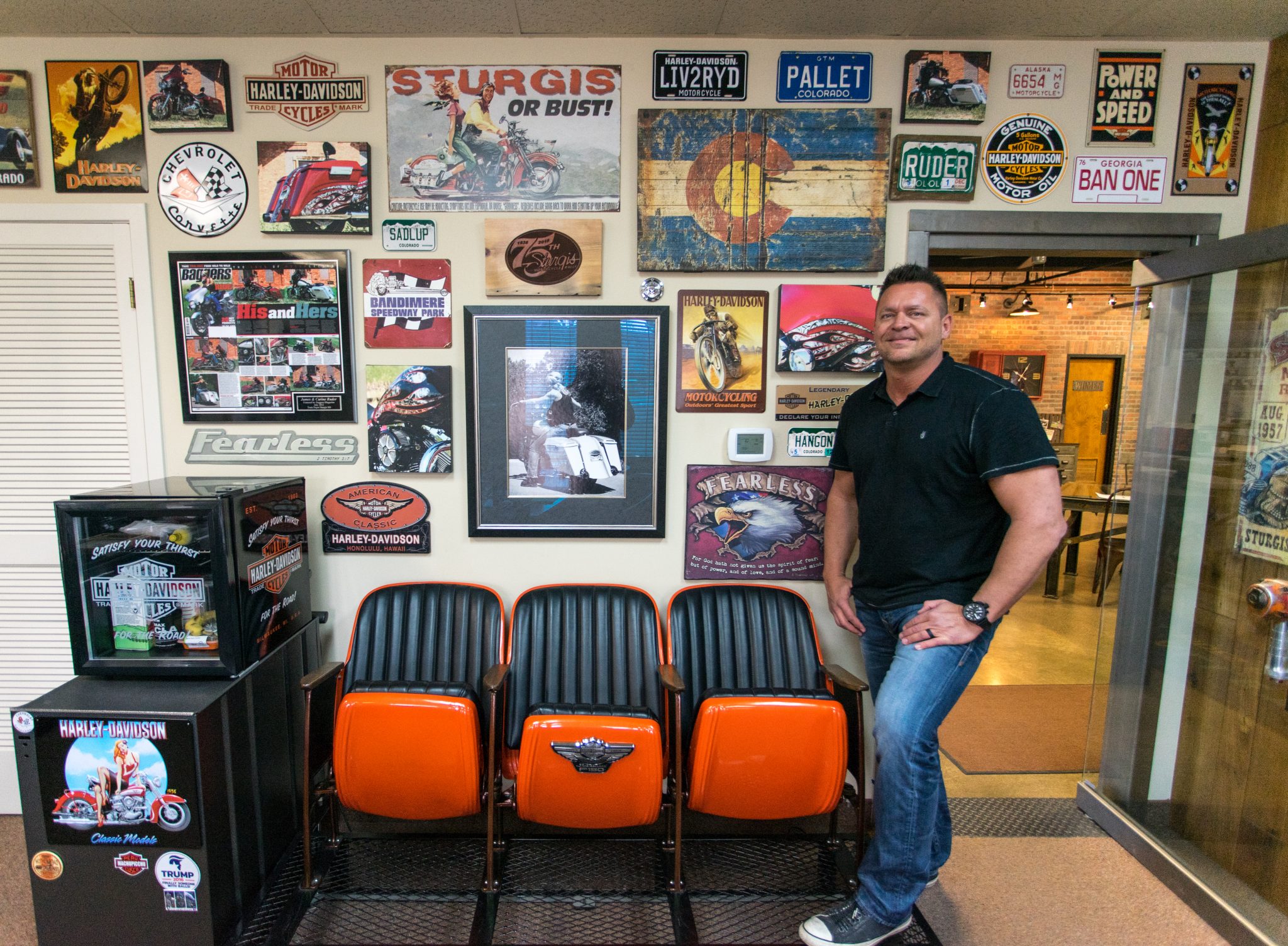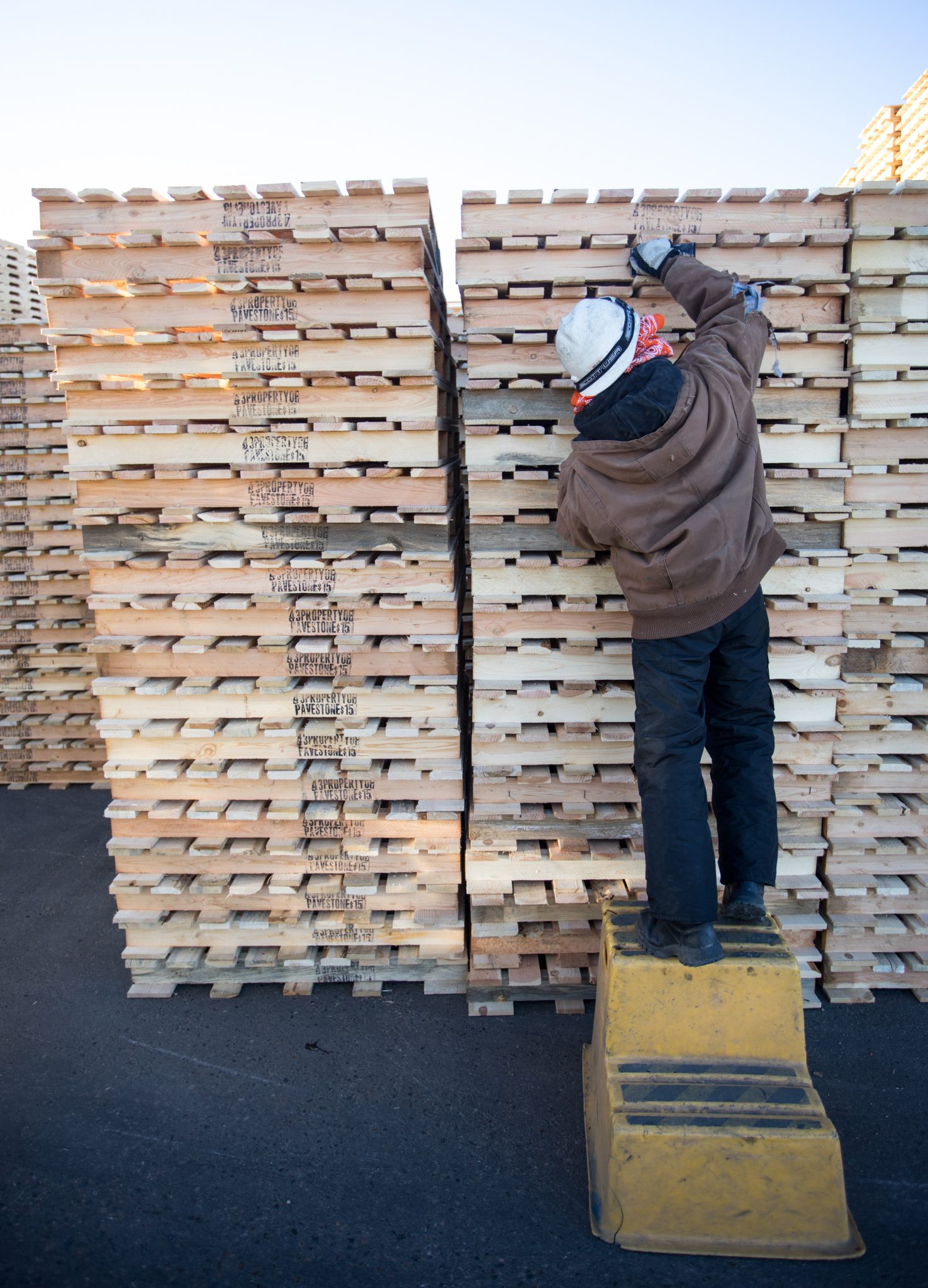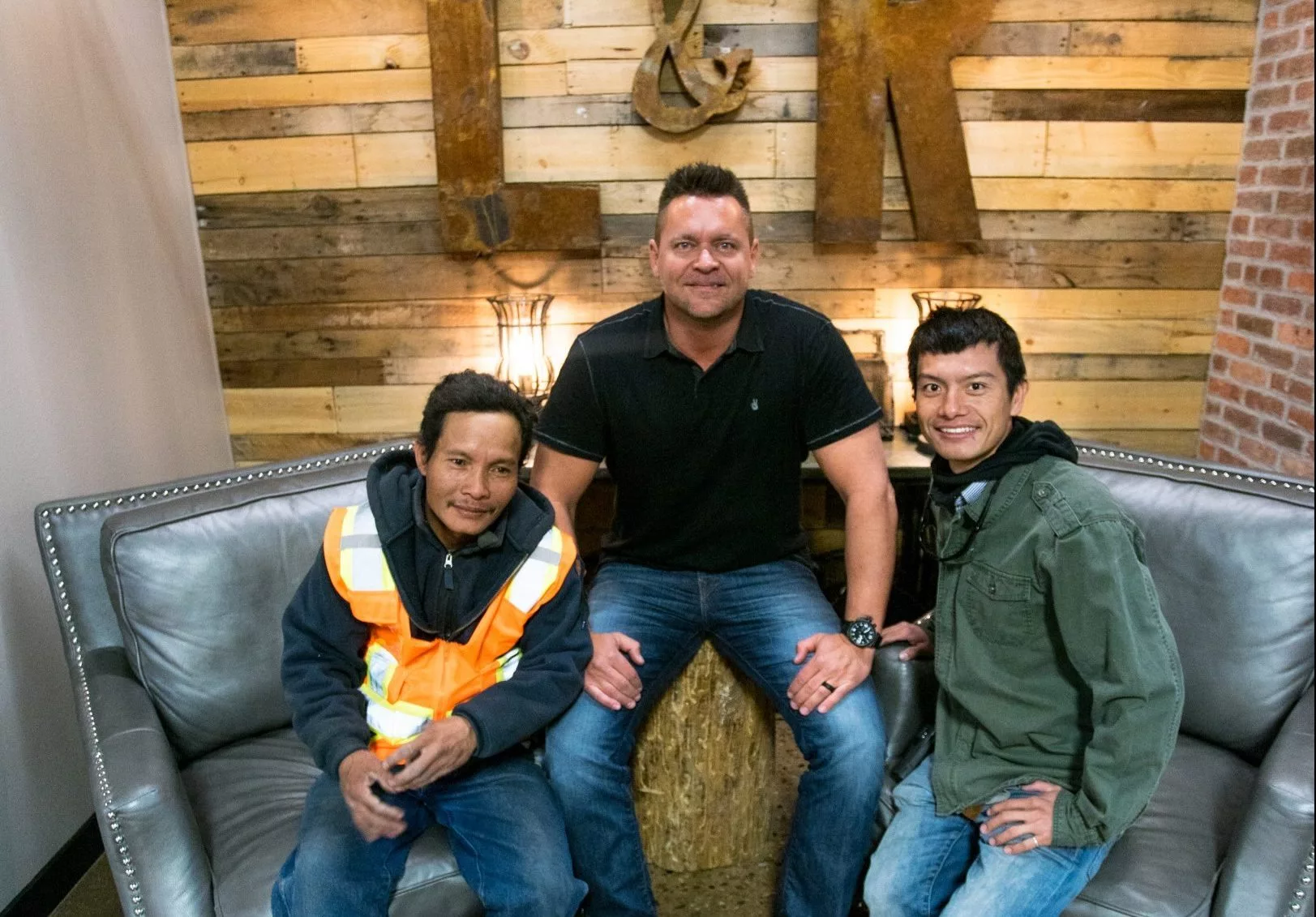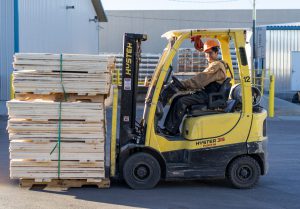L&R Pallet at a Glance
Location: Denver, CO
Founded: 1974
Team Members: 120
Structure: Private manufacturing company
Impact: Nearly 70 percent of employees are refugees
The Story
On March 20, 2010, James Ruder, 42 years old and six feet tall, a Harley Davidson enthusiast with a solid build and spiked dark-blond hair, sat with his family holding hands around the dinner table in the house they had built just two years earlier. Typical brisk, sunny weather marked the start of spring in Castle Pines, CO, a small town south of Denver. Yet as the sun fell below the horizon, more than the temperature outside grew colder — it hardly felt like a day to celebrate new beginnings.
With a leaden feeling in his chest, Ruder and his wife faced their three children to tell them that their company, L&R Pallet Service Inc., was dying. After 36 years as the family business, L&R was facing dire financial trouble, and Ruder wasn’t sure he could fix it, especially during the ongoing recession. Tears traced Ruder’s cheeks as his family sat in stunned silence. Then the volley of questions began. “Will we have to sell our home? How much will we have to downsize? Will the kids need to change schools?”
L&R’s woes had already been weighing on Ruder; the fear in his family’s voices brought the hurt to another level. His business challenges felt like a deep, dark, winter night that might never end. Little did he know that the company’s troubles were about to get even worse — and that finding his way out of the mess would require a series of transformations both more intimate and more public than he could have conceived. Yet by 2017, L&R Pallet would become a prime example of how businesses can flourish, in all senses of the word, by investing in a purpose beyond simply making money. In L&R’s case, that newfound purpose is creating a supportive community for an employee base of refugees — a goal the Ruder of 2010 couldn’t have fathomed.
The remarkable evolution of Ruder as a leader, of his priorities for L&R, and of the company’s role in society took years to unfold. It followed a winding path, full of false starts and dead ends, and lots of stress and pain. Looking back on it now, there were probably easier ways to get from there to here, but Ruder couldn’t see what “here” looked like, as he had neither role model nor map available. That’s why it’s so important we share this story of how L&R became a flourishing, inspiring example of an exceptional workplace culture — especially in the manufacturing trades — and how Ruder himself found a new sense of meaning in his life’s work. L&R’s story holds universal lessons about the power of culture, purpose, and mission in both the workplace and life.

Ruder in his office. Employees now call L&R Pallet “a second home.”
Ruder’s parents, Larry and Dorris, founded L&R Pallet in 1974. Larry, a former employee of Coca-Cola, saw an opportunity in the number of pallets the company used every day for storing, shipping, and transporting goods. With $500 on a credit card, the Ruders started a business in the family’s basement, building new pallets and refurbishing used ones. Over the next decade, they grew L&R into a thriving company, earning enough to allow them to take a family vacation for the first time. In 1993, Larry began to transition ownership of the business, with its 12 employees and annual revenues of $1 million, to his son James, who was in his mid-20s.
Like his father before him, James Ruder believed in an honest day’s pay for an honest day’s work, and made a point not to get involved in his employees’ lives. He expected them to show up and work hard, and in exchange L&R would provide a stable job. The vibe was, as one employee put it, “When you get here, you check your emotional baggage at the door because I need your full-time focus.” Ruder was somewhat suspicious of his employees, expecting that they were there just to collect a paycheck and maybe file a worker’s compensation suit. It was a typical manufacturing setting with typical management.
His workers, meanwhile, had little loyalty for the company. Building pallets is not a glamorous job; entry-level workers stand in an open yard in all weather, pulling 50-pound pallets off trucks and sorting them for refurbishing. Whenever employees had the opportunity to leave for other jobs, they did.
In 1996, the company was raided by the US Immigration and Naturalization Service. Ruder staffed his team primarily with Latino workers whose immigration status he hadn’t confirmed; that day, officials dragged away 38 of them. Twelve more narrowly escaped after hiding within the plant, but never returned to work.
L&R Pallet was never fined for its immigration violations, but its workforce was decimated, and hiring and retention soon became the company’s continual sore spot. For the next 14 years, the business was chronically understaffed. “We hired six to seven people a week,” says Ruder. L&R would provide each new worker with $50 worth of uniforms and some brief training, and then, time after time, the employee would quit within a few days. At its worst point, L&R Pallet faced 300 percent annual employee turnover. Ruder was paying $20 an hour, yet even as the 2008 recession sent unemployment soaring, he and his plant manager were constantly struggling to recruit and retain.
Meanwhile, because the company was desperate for anyone willing to work, hiring managers didn’t perform drug screenings and couldn’t be picky about who they brought on. With a scant three days of training, workers would drive forklifts too fast, injuries were piling up, and quality issues were mounting. Verbal confrontations were common, and — unbeknownst to Ruder — the plant manager was blackmailing workers to fuel his growing drug problem. The workforce L&R could attract was struggling just to build enough pallets each day.
By 2010, L&R Pallet’s annual sales had fallen from a high of $17 million in 2008 to $15 million, and the business had stopped being profitable, no matter what Ruder tried. As he sat with his family around the dinner table that night in March, he felt as though he had hit rock bottom. After a long, difficult conversation, Ruder’s wife assured him that they would get through whatever was going on. But Ruder felt tortured by a sense of failure.
That week, in a renewed attempt to understand where the business’s money was going, he tried some new procedures he thought could help the situation, including requiring every delivery truck to stop at the front office for a cargo inspection. Much to Ruder’s surprise, over the next three days the company received less than half the goods it had typically been recording and paying for — from multiple outside vendors.
A few days later, Ruder bolted awake at 2:00 a.m. with an idea: he should watch the surveillance video of the delivery trucks coming into the yard. Within an hour, he was at the office reviewing the previous day’s surveillance tapes. As night turned to morning and then to afternoon, Ruder shut himself away to review days of video and compare records for a week of transactions. The discrepancy between the deliveries L&R was paying for and what it was actually receiving added up to about $25,000. And that was just for one week. Ruder felt a rising sense of shock, panic, and disbelief. With hands shaking, trying to keep his voice calm, he called his local police department and asked for an officer to be there as he fired the assistant manager responsible for turning in those trumped-up invoices.
Over the next few days, Ruder discovered that during the previous six months, not only his assistant manager but his plant manager, in collaboration with four vendors, had siphoned approximately half a million dollars from the company. The plant manager was supporting a cocaine addiction by stealing, manipulating paychecks, and threatening to fire workers if they spoke up. L&R Pallet was entangled in a major embezzlement scheme involving long-tenured, trusted employees. Ruder was devastated — and watched any faith he once had in his staff evaporate. “I felt like the business had cancer and was dying,” he says.
As the embezzlement case moved through the criminal justice system over the next few years, Ruder decided to run the business without replacing the managers. He worked 14+ hours a day, sleeping in the basement at home so he wouldn’t disturb his wife with his restlessness. Yet all his grinding, all his effort, didn’t seem to be making a difference. He was still short-staffed, exhausted, and desperate for a change. He rarely saw his family. He knew there had to be more to life than just work and stress. Something had to give.

An employee stamping pallets. Ruder now fields inquiries from other businesses about how L&R has such a strong workplace safety record.
The call from the local refugee resettlement agency came on an ordinary Tuesday in October 2013. Would L&R Pallet be open to hiring workers who had fled their home countries and were making new lives in Colorado? Ruder mulled it over. He’d tried hiring refugees once before, in the mid-’90s, but five of the six Bosnian workers he’d brought on had quit within a few months, just as the rest of his staff usually did. Still, the risk seemed low — he was always desperate for workers. Within two weeks, Ruder welcomed seven men from Burma to L&R’s standard three-day training on pallet assembly.
It was quickly clear to Ruder that these workers were different somehow. Within less than a week, the Burmese men were outperforming nearly all of their peers. They showed up to work early and waited outside the door to begin their shifts. They didn’t try to sneak in breaks when they thought supervisors weren’t looking — in fact, they never stopped working, even in cold, wet weather. Ruder felt like he’d hit the jackpot. He called the agency back and asked for as many more workers as they could send. By December 2013, L&R had hired another 18 refugees, including people from the Congo, Nepal, and Somalia, plus more from Burma.
Rather than the magic bullet he’d hoped for, though, this batch of new employees was, as Ruder puts it, “a complete disaster.” Instead of being reliable and eager like the first group, the 18 new hires would often just not show up to work, without even calling. Almost every week, a new employee would shoot himself in the hand or ankle with the high-powered nail guns workers used on the job.
In the past, Ruder might have simply fired all the poor performers and chalked the experiment up as a failure. But over the previous year or two, something inside Ruder had started to shift. The transformation was gradual and complicated — as most big things in life are. On a day-to-day level, the trust he felt in the new plant manager he’d finally decided to hire, a man named Jay Doyle whom he’d spent years getting to know and months courting to join his team, must have helped. With the company’s day-to-day operations in reliable hands and the sting of the embezzlement fading with time, Ruder found himself feeling hungry for something more to his work than just running a decent business and cracking the nut of making more and more money. He was looking for purpose, for meaning.
The embezzlement right on the heels of the recession likely had something to do with it; as Ruder puts it, “If somebody doesn’t hit bottom, do they look up?” The maturity of midlife, of being in his 40s and starting to think about the legacy he might leave, also played a role. Ask him about what changed, specifically, and he’ll tell you about a mission trip to Peru, an electric touch on the arm from an orphan girl that brought him to his knees, and a message from God like a kiss on the forehead, saying, “I need you to care about people.” As he began to soften and open, what he heard God telling him, again and again, was a strong message about love for those around him — including his employees.
So instead of giving up on the new refugee hires, or focusing on the negative, Ruder made a choice that would turn out to be pivotal for the business: he decided to listen. His first move was to talk with each of his 25 refugee employees individually. He quickly learned how many of his basic assumptions about these men were wrong. For example, he’d figured that if 10 of them were from Burma, they’d all speak the same language and need just one translator. The resettlement agency hadn’t mentioned otherwise. Instead, he found that men from the same country spoke different languages or dialects and came from different sects. Even basic communication was going to take more work than Ruder thought. But instead of getting discouraged, he sought out additional translators.
The interviews helped him piece together why the first batch of hires had been so much more successful than the second: the seven Burmese men he’d brought on first had all been in the US for several years before joining L&R. That meant that they’d had time to get settled and learn the expectations around attendance and other norms at US workplaces. Meanwhile, the men in the second group, who were mostly new arrivals, had all kinds of immediate needs Ruder hadn’t considered: doctor’s appointments for long-overdue physicals, vaccines, and medical care; school registrations for their children; connections to social services; obtaining social security numbers; finding housing; figuring out public transportation; getting a driver’s license; etc. No wonder they were missing a lot of work.
Despite the obvious challenges of working with a population with so many needs, there was something about the refugees that made Ruder want to double down on figuring out how to connect with them. It was partly that he already had clear evidence of their unusual dedication: even when an injured refugee’s doctor told him to stick to light-duty work after he nailed his fingers together, for example, Ruder would find the worker back on a heavy-duty job.
But Ruder’s growing connection with God and sense of a mission to spread love probably played an even bigger role. He was truly ready to try something different than the “stay out of employees’ lives” mentality that was the norm in his industry. After the interviews, he realized that he’d have to invest more if he wanted this new batch of refugees to be the ray of sunlight the first batch had been. After all the spiritual work he’d been doing, he was open to that. So he set to work.
Knowing he had to do something quickly to stop the injuries, Ruder built a complete replica of the shop floor in a separate small building that he could use exclusively for training. Company foremen started labeling every refugee’s hard hat with the language he spoke and gathering those with a common language together to help make communication more effective. Rather than relying on translators to explain what to do, trainers began focusing on demonstration and using touch. Where the company used to throw a new hire on full production after three days of training because it was so desperate to increase output, it now began spending two months getting each refugee up to speed.
The new training program solved the injury problem, but Ruder soon faced another challenge: some of his existing workforce and office staff resented the focus on the newcomers. He would have to do even more to create a sense of community where all workers felt valued.
Workplace culture” isn’t a term Ruder would have used when talking about what he was changing, because it’s not a term that any of his mentors or role models ever used. But looking back, changing the workplace culture was exactly what he was learning to do.
Most experts define “workplace culture” as the sum of the norms, behaviors, values, and expectations around how a workplace operates. It’s everything from the routines of how people start their day to the way leadership teams handle conflict to the expectations about what “good customer service” means. The idea that workplace culture matters is becoming increasingly mainstream among, say, tech companies or startups, but for a family-run manufacturing business like Ruder’s, it’s not a buzzword that comes up very often.
Yet for any business, a high-functioning culture is arguably the number one driver of innovation, employee engagement, job satisfaction, and — by extension — financial success a company can have. “No company, small or large, can win over the long run without energized employees who believe in the mission and understand how to achieve it,” says Jack Welch, former CEO of GE.
There are resources and research out there about workplace culture best practices, but none were visible in Ruder’s world. So he and Doyle began to focus on employee culture using a process of trial and error to invent practices that worked and aligned with Ruder’s newly elevated values around relationships and love.
With the refugees’ high motivation level and strong performance, management soon could be more selective and let go of underperforming employees or those with bad attitudes. They put new programs in place to recognize employee milestones like anniversaries and installed a screen in the front office to display rotating photos of the team at work. Managers began holding daily pre-production meetings to discuss and support employee needs.
Meanwhile, Ruder started doling out bear hugs and shoulder rubs and talking with his employees more regularly. He learned whose wives were pregnant, how many children each of the workers had, who was trying to buy a home, and who was having marital problems. The longer-term workers who’d stayed on slowly discovered that Ruder wasn’t just helping out refugees; he was treating all employees differently. “He was not the same guy as he previously was,” says Doyle. “He started to love his employees.”
By 2016, Ruder was ready to ramp up the investment in creating a truly supportive workplace, both for refugees and for “regular” employees. Starting that February, he assigned one of his managers, Chris Courtney, to spend 20 hours a week handling employee issues. Ruder gave him the informal title of “internal ministry director,” a nod to the religious mission trips that had been important catalysts of his own evolution toward compassion and care.
Courtney’s scope extended far outside the workplace: he reviewed apartment leases, accompanied employees to court in custody disputes, and even went to homes to spray for bedbugs when landlords were derelict in their duties. The company started an annual free clothing drive for employees, weekly church services in four languages, and optional English classes on site. After learning more about how to work with refugee populations, it also reworked attendance policies to be more focused on rewards than on punishment.
In 2017, Ruder hired another employee — this one full-time — as an actual chaplain to help counsel all employees through whatever challenges they were facing. “We used to say the refugees were broken and hurt,” Ruder says. “But now we treat every employee that way.”
Because of all the changes that have taken place at L&R over the past four years, “Everyone has become more tender and humane,” says Ruder. His favorite example: a tough Mexican manager brought in one of the Burmese workers who was crying and implored Ruder to “help my little guy.”
Ruder has no doubt the investment is well worth it. He’s employing 1.5 managers to handle worker relations, yet he doesn’t need much HR staff because there is such low turnover now. “Before, I hired six-figure people to take care of my physical assets,” he explains, “but who was watching out for my human capital? We have to offer something beyond just a wage. We need to give people a family; we need to give them a support group.”
Ruder is now more concerned about the people who work for him than he is about sales, production, or other more traditional business metrics. He even turned this newfound passion for relationships toward his clients: in 2013, he decided to stop working with customers who didn’t treat his staff with respect. In practice, that meant walking away from two big accounts and hundreds of thousands in revenue, but it showed his own team how serious he was about the importance of love in the workplace. Meanwhile, employees have begun to think of L&R Pallet as a second home.
Creating a safe, caring community for refugees hasn’t just given Ruder a renewed sense of joy and purpose in life; it has also reinvigorated the business. In 2016, L&R Pallet finished with its best financial year yet. Because of the focus on creating community, when the company needs to add employees, existing staff now recommend their friends and family members. Turnover has essentially been eliminated, down from 300 percent to between 5 and 10 percent. And of the 120 employees working for L&R Pallet, 85 are now refugees. Ruder’s next goal is to be the best-paying pallet company in Denver.
Ruder looks back on that rock-bottom day in March 2010 and feels like a different person. It would be wrong to say the refugees themselves fixed Ruder’s business, or changed him into a new man, or that Ruder had a clear plan when he decided to bring them on. The magic came from the synergy of the personal transformation that allowed Ruder to lead a more open-hearted culture with the societal mission L&R stumbled into. It took both an internal evolution on Ruder’s part and a reorienting of the business’s priorities to drive the change. But now, in addition to selling its product, L&R Pallet is playing a big, important role in its community by building a safe haven and providing jobs to a vulnerable population. And Ruder now spends more time than his wife might like talking to vendors, customers, and other manufacturing businesses about how he keeps his injury rates and turnover so low — the secret to his success. In his words, it’s actually radically simple: “We just have to love on people.”
Extra
5 Benefits of Hiring Refugees
1. Optimism. Refugees have faced much more difficult situations than those they’ll encounter at your company, so they are often resilient, optimistic, and hopeful. They tend not to get stressed out over things your other employees might freak out about unnecessarily.
2. Appreciation. Due to differences in language and culture, refugees’ knowledge, skills, abilities, and talents tend to be overlooked. By investing in the training and processes necessary to put those assets to use at his company, Ruder has tapped into a generally respectful and appreciative workforce.
3. Loyalty. Refugees have fled their home countries seeking safety from persecution, war, or violence. If welcomed into a company and provided with the psychological safety they need, they tend to be very loyal and dedicated employees.
4. Work Ethic. Most refugees want to work in order to restore the sense of self that was stripped by the persecution they faced, and to repay their debt of gratitude to the resettlement country providing them with protection. At L&R Pallet, Burmese refugee workers quickly set a new standard for the pace of operations.
5. Fresh perspective. Refugees who have spent years in a refugee camp before being resettled have learned to make do with extremely limited resources. As such, refugees are courageous, resourceful, ingenious, and creative, and they may perceive problems from a completely different perspective. The key to tapping into this perspective is to ask the refugees what they think and to make sure to show them that speaking up and giving ideas to management is an acceptable and appreciated practice. Many might have come from cultures where employees would never question or provide suggestions to the boss.
Related story
 12 Important Things to Know Before Hiring Refugees
12 Important Things to Know Before Hiring Refugees
Hiring refugees helped transform Denver’s L&R Pallet for the better, but it’s not a silver bullet. Here are 12 things to know before you try.

 12 Important Things to Know Before Hiring Refugees
12 Important Things to Know Before Hiring Refugees



